
Bethy Rubinstein
 Menashe Kadishman
Menashe Kadishman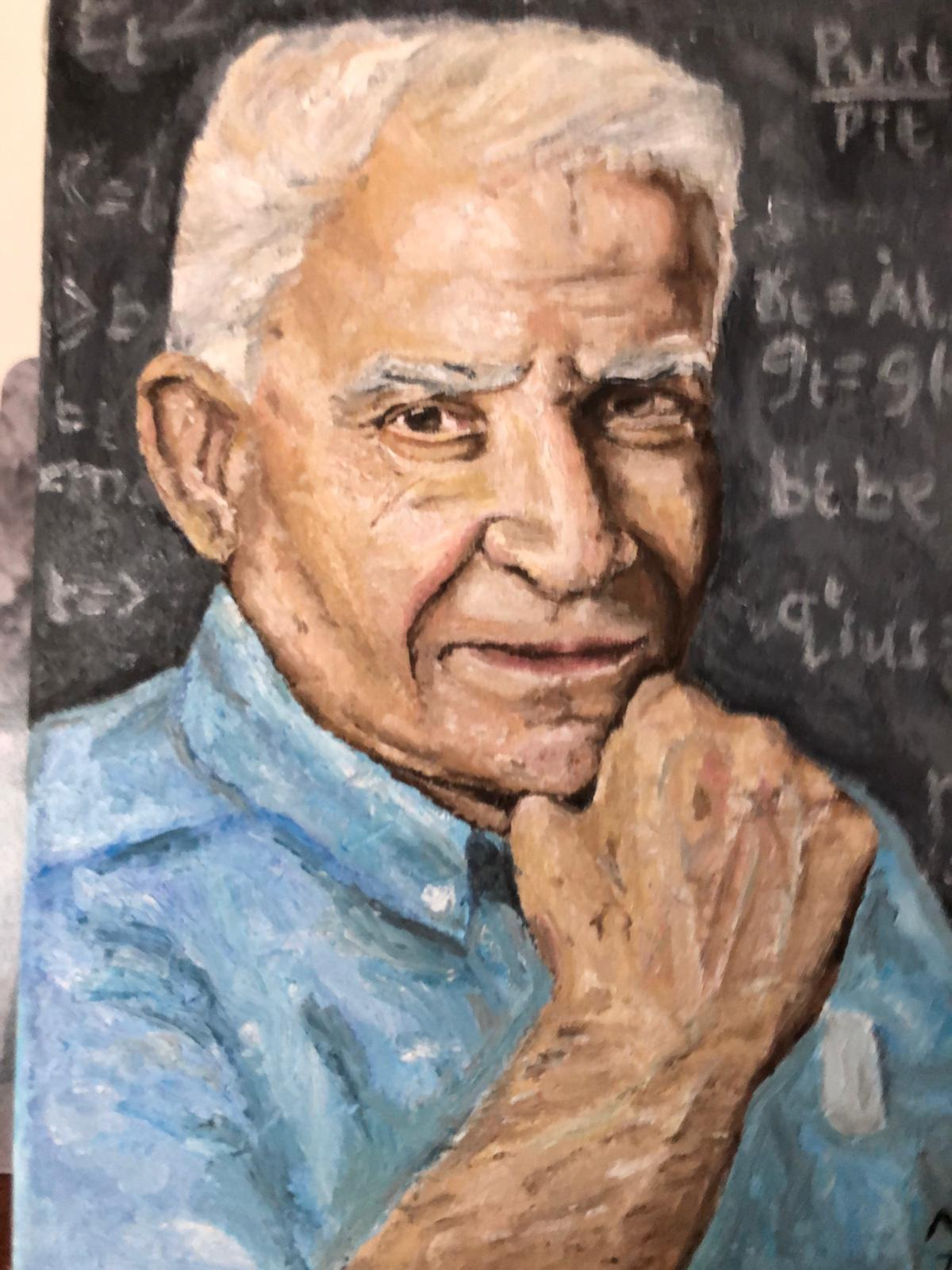 Neeve Razin, 2021
Neeve Razin, 2021
Preface
In the contemporary arena of political discourse, the transition from liberal democracy to its illiberal counterpart has become a focal point of academic discussion. Notable instances in Hungary, Poland, Turkey, and the attempted judicial overhaul in Israel serve as poignant examples, shedding light on the gradual erosion of democratic principles.
While scholarly attention has predominantly focused on the political dimensions of these shifts, the multifaceted economic aspects remain relatively unexplored within the literature. Through a collection of essays, we aim to delve into the economic structural changes that coincide with this pivotal shift.
This e-book endeavors to address this gap by offering an early and insightful examination of the economic transformations accompanying the transition from liberal democracy to illiberal democracy, and their drivers.
The transition to illiberal democracy is a concern in the countries the book deals with - Hungary, Poland, and Israel. But it is also a grave concern in the US and in India, and Mexico. Mexico is furthest along the illiberal track. Instances like Brexit in the United Kingdom, the world's oldest democracy, highlight how populist based economic policy can imperil liberal democracy. In Israel as in Poland (especially after the recent election), there is at least a basis for believing the crisis is receding. To many, the upcoming November 2024 US is the most concerning given its democracy leading global position. So far, the judicial weakening has come about mostly with
the politicization of the appointment of justices to the courts. It is spreading to more and more issues and more and more courts.
The essays contained herein explore the various political drivers behind these transitions, including economic disparities, identity politics, the influence of social media and echo chambers, educational quality discrepancies, and disparities in access to societal and financial institutions. Moreover, the book delves into the ramifications of anti-democratic forces on economic growth, examining their impact on areas such as social media dynamics, educational quality, foreign direct investment, the hi-tech industry, and entrepreneurship. Essays authored by scholars with intimate knowledge and expertise in their respective fields, including Itai Ater, Dan Ben-David, Barry Eichengreen, Ayal Kimhi, Itzchak Tzachi Raz, Assaf Razin, Efraim Sadka, Yannay Spitzer, Adam Szeidl, Ferenc Szucs, Eran Yashiv, and Noam Yuchtman, this collection offers a comprehensive exploration of the economic dimensions of democratic erosion.
I extend my gratitude to my colleague, Haim Ben Shahar, whose insights were instrumental in shaping the intellectual inception of this e-book project. I am thankful to Anne Kruger comments on an earlier draft. Additionally, I acknowledge Nir Lavee for his invaluable editorial assistance.
Assaf Razin
February 24, 2024
DISTINCTIONS
2017 Emet Prize In Economics: Jerusalem Post reports.pixsHebrew press
IEA (International Economic Association) Fellow award for 2022
1994 - Fellow of the Econometric Society
!995- Fellow of the European Economic Socity
2023 - Research.com Economics and Finance in Israel Leader Award
2022 - Research.com Economics and Finance in Israel Leader Award
1990 Elected Fellow of the European Economic Association
2023 - Research.com Economics and Finance in Israel Leader Award
2022 - Research.com Economics and Finance in Israel Leader Award
Well-Cited Articles
Effective Tax Rates in Macroeconomics: Cross-Country Estimates of Tax Rates on Factor Incomes and Consumption
Enrique Mendoza;Assaf Razin;Linda Tesar.
Research Papers in Economics (1994)
1863 Citations
Fiscal Policies in the World Economy
Jacob A. Frenkel;Assaf Razin.
Journal of Political Economy (1986)
1288 Citations
Fiscal policies and growth in the world economy
Jacob Frenkel;assaf razin;chi-wa Yuen.
MIT Press Books (1996)
1018 Citations
Fiscal policies and growth in the world economy
Jacob Frenkel;assaf razin;chi-wa Yuen.
MIT Press Books (1996)
992 Citations
Current Account Reversals and Currency Crises; Empirical Regularities
Gian Maria Milesi-Ferretti;Assaf Razin.
Research Papers in Economics (1998)
736 Citations
The Terms of Trade and the Current Account: The Harberger-Laursen-Metzler Effect
Lars E. O. Svensson;Assaf Razin.
Journal of Political Economy (1983)
732 Citations
Sustainability of Persistent Current Account Deficits
Gian Maria Milesi-Ferrett;Assaf Razin.
Research Papers in Economics (1996)
518 Citations
Current Account Reversals and Currency Crises: Empirical Regularities
Gian Maria Milesi-Ferrett;Gian Maria Milesi-Ferrett;Gian Maria Milesi-Ferrett;Assaf Razin.
Social Science Research Network (1998)
444 Citations
International tax competition and gains from tax harmonization
Assaf Razin;Efraim Sadka.
Economics Letters (1991)
442 Citations
Current-Account Sustainability
Assaf Razin;Gian Maria Milesi-Ferretti.
(1996)
WORKS ON  FOREIGN DIRECT INVESTMENT: ANALYSIS OF AGGREGATE FLOWS: CO-AUTHORED WITH EFRAIM SADKA, THIS BOOK PROVIDES A COMPREHENSIVE ANALYSIS OF THE FACTORS INFLUENCING FDI AND ITS ECONOMIC IMPACTS. UNDERSTANDING GLOBAL CRISES: AN EMERGING PARADIGM: THIS BOOK EXPLORES THE ROLE OF GLOBAL FINANCIAL INTEGRATION, INCLUDING FDI, IN FINANCIAL CRISES AND ECONOMIC STABILITY. INTERNATIONAL TAXATION IN AN INTEGRATED WORLD: THIS WORK EXAMINES HOW INTERNATIONAL TAX POLICIES INFLUENCE FDI AND THE IMPLICATIONS FOR GLOBAL ECONOMIC INTEGRATION.

 Avner Bengal bengal
Avner Bengal bengal
Affiliations
Fellow of the Econometric Socity
Former President of Israel Economic Association
NBER Research Associate;
CEPR Reseasrch Fellow;
CES-ifo Research Fellow; IZA research Fellow.
Eitan Berglas School of Economics,
Tel Aviv University,
Tel Aviv 69978
ISRAEL
Office Telephone: 972-3-640-7303, mobile: 972 58 7900033
Fax: 972-3-642-8074,
or 972-3-640-9908 (Office)
972-3-641-4475 (Home),
e-mail: razin@tauex.tau.ac.il, ar256@cornell.edu, Home Page: http://www.tau.ac.il/~razin
 Amos Keinan
Amos Keinan
 Arie Lubin
Arie Lubin
Yom Kippur
https://www.youtube.com/watch?v=yspXvbBPrXc
Yair Rosenblum composition of נתנה תוקף, a Byzantine- period text(פיוט), which is discovered in the Cairo Genizah–The collection of some 400,000 Jewish manuscript fragments and Fatimid administrative documents that were found in the genizah or storeroom of the Ben Ezra Synagogue in Fustat or Old Cairo, Egypt. The centuries- (or millennial-) old text caught the eyes of Yair Rosenblum. He lived at the time in Kibbutz Beit Hashita — a small community in Jezreel Valley, which lost 11 of its sons in the 1973 Yom Kippur War. Yair put new life to the old text, and his composition became a memorial hymn. After is death, Yair Rosenblum was buried near my son OFER's grave, in another small community, Kibbutz Einat, near my son OFER grave.
Leonard Cohen, who visited the front during the Yom Kippur War, rephrased the old prayer נתנה תוקף:
"And who by fire, who by water
Who in the sunshine, who in the night time
Who by high ordeal, who by common trial
Who in your merry merry month of may
Who by very slow decay
And who shall I say is calling?
And who in her lonely slip, who by barbiturate
Who in these realms of love, who by something blunt
Who by avalanche, who by powder
Who for his greed, who for his hunger
And who shall I say is calling?
It became known in the entire world.
 Avner Bengal
Avner Bengal
New:
The Transition from Liberal Democracy to Illiberal Democracy: Multifaceted Economic Shifts
Assaf Razin
(Editor)
2024
Globalization, Migration, and Welfare State
Understanding the Macroeconomic Trifecta
Author: Razin, Assaf

This book is about three key dimensions in economics—globalization, migration and the welfare state—that are of enduring interest. These issues are particularly important to consider at the present moment given the strains posed by the pandemic: there is at least a temporary setback to trade-globalization and migration, and the cost of fighting the pandemic will strain the ability of governments to provide welfare state services in a style and scope to which many of their citizens have become accustomed. The book explains the changing function of the welfare state in the presence of intensified globalization, or de-globalization, forces. The welfare state’s policy-maker attitudes toward openness and migration depend on open-economy fundamentals, and the income class it represents. The author demonstrates the interactions between migration, globalization and macroeconomic policy in practice, using real-world unique episodes, with Israel deemed as well-functioning trifecta, and the US and Europe as imperfectly functioning trifecta.
TEXT PDF
Book Review: Giovanni Facchini (link)
Israel and the World Economy: Power of Globalization
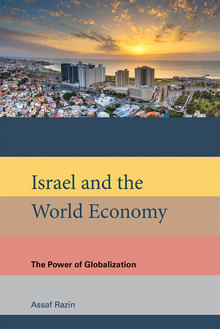
Anti-globalization sentiment is growing, especially in Europe and the United States, with the increasingly integrated global economy blamed for domestic economic distress. I show that Israel offers a counterexample to this view, by demonstrating the decisively positive economic effects of globalized finance, trade and immigration. The emerging market economies such as China, Vietnam, India and Indonesia abandoned autarky in favor of export-led growth in the mid-1980s. Suddenly, and with little warning, more than a third of the world’s population joined the postwar globalization parade, powerfully effecting global demand everywhere, including Israel. Israel has significantly pivoted its trade to the emerging East Asian markets.
What's the book about
Slides
Endorsements:
Israel's economic experience contains many highly relevant lessons: how to tame inflation, how to absorb immigrants, how to make the transition to high-tech, and now how to cure the Dutch Disease. There can be no better guide than Assaf Razin to lead us through this wilderness.
(Barry Eichengreen,, University of California, Berkeley)
Many countries struggle to adapt to the forces of globalization. Some turn their backs on globalization and listen to the sirens of protectionists. In this book, Assaf Razin shows how Israel did the opposite and used globalization to its advantage. It makes for fascinating reading.
(Paul De Grauwe, London School of Economics)
Israel and the World Economy:The Power of Globalization
Public Lecture (video)
Hebrew Parts (pdf)
Slides (Powerpoint) (pdf)
Figures
Interview (hebrew)
A rigorous analysis of the role played by globalization in key episodes in the development of the Israeli economy, from hyperinflation crisis to high-tech surge.
Anti-globalization sentiments are rising, especially in Europe and the United States, with the increasingly integrated global economy blamed for domestic economic distress. In this book, Assaf Razin argues that Israel offers a counterexample to this view, showing decisively positive economic effects of globalized finance, trade, and immigration. He offers a rigorous analysis of the role played by globalization in key episodes in the remarkable development of the Israeli economy. His findings may hold lessons for productivity-challenged advanced economies as well as for other countries such as China currently making the transition to fully developed economies.
I examine the wave of immigration after the collapse of the Soviet Union, as highly skilled Soviet Jews migrated to Israel and the effect on income inequality; the Great Moderation of inflation and employment in advanced economies, as Israel's inflation converged in parallel with low world inflation rates; Israel's robustness in the face of the deflation shocks of the 2008 financial crisis; and technology transmission through foreign direct investment, reinforcing Israel's high-tech sector surge. He also considers such ongoing challenges as high fertility and low labor market participation and the economic costs of the Israeli-Palestinian conflict.
Book Reviews
Book Reviews:
Laura Alfaro, Israel Economic Review Vol. 15, No. 1 (2018), 111-115
http://www.boi.org.il/en/Research/Periodicals/Documents/volume%2015.1/פרק%205 .pdf
Asaf Zussman, Israel Economic Review Vol. 15, No. 1 (2018), 107-109
http://www.boi.org.il/en/Research/Periodicals/Documents/volume%2015.1/פרק%204 .pdf
David Rodman in Israel Affairs
Phillip Swagel, FINANCE & DEVELOPMENT | December 2018
(link)
 uri Lifshitz
uri Lifshitz
Assaf Volume I: The first 70 years
A BIOGRAPHY in COMICS
(link) -------------------------------
Assaf Razin's life stroy is one of extremes. It follows Assaf rom the Kibutz to the city, from Israel to different parts of the world, from his childhood in the nursery bed of socialism, to the Economics Department in Chicago University, the cradle of intellectual capitilism. Our hero persues a stelar carreer and personal acheivements while withstanding rather dramatic personal events.
 Menashe Kadishman
Menashe Kadishman
Published
E-books by Assaf Razin (link)
 Jankel Adler
Jankel Adler
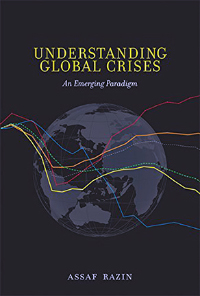
Talk at Warwick University (link)
Three Branches of Financial Crisis Theory (Goldstein and Razin)
Ten years ago Wednesday, Aug. 9, 2007, French bank BNP Paribas blocked withdrawals from hedge funds that specialized in U.S. mortgage debt. That Aug. 9, 2007, marked the beginning of a credit crisis that caused investment bank Lehman Brothers to collapse a year later and usher in the Great Recession of 2007-09.
1. Understanding Global Financial Crises: An
Emerging Paradigm,
by Assaf Razin
MIT PRESS,
December 2014 (link)
Book's Narrative (link)
Financial crises have some common storylines, among them bursting asset bubbles, bank failures, sharp tightening of credit, and downturn in trade. They are also different from one another. Some start with sudden reversal of international capital flows, others with domestic credit implosions. A challenge to economic research is to integrate common as well as disparate threads into a coherent analytical framework that is at the same time empirically testable. In Understanding Global Crises: an emerging paradigm, I offer a review of an emerging macroeconomic paradigm incorporating failure-prone financial intermediaries, that is consistent with the key features of recent global financial crises. To be self ccontained, the book also presents in a transparent way basic analytical elements of the theories of financial and monetary and currency crises.
Contents:
1 Introduction
Part I Recent History of Financial Crises
2 The 1990s and the Early 2000s
3 The 2008 Global Crisis
4 The Crisis in the Euro -Zone
Part II Elements of the Theory of Financial Crises
5 Analytics of Financial Fragility of Banks
6 Analytics of Credit Frictions and Capital Market Freezes7 Analytics of Asset Bubbles and CrisesPart III Exchange Rates and Capital Flows
8 Analytics of Currency Crises
9 Foreign Investment and Debt: Information Asymmetry
10 Foreign Investment in the Presence of Liquidity ShocksPart IV An Emerging Macroeconomic Paradigm: Financial
Intermediaries, and Credit Frictions
11 Inflation-Output Trade-off with Frictionl-Less CreditThe Benchmark
Paradigm
12 Leveraging, De-lLeveraging and the Liquidity Trap
13 Amplification and Persistency of Shocks in Dynamic Macroeconomic
Models
14. Epilogue
Endorsements:
Assaf Razin provides here the definitive introduction and overview of the historical and analytical literatures on financial crises. Students new to the subject and specialists alike will appreciate the crystal clear exposition. Razin's book is the obvious starting point for all those concerned to understand risks to financial stability. And, given recent events, 'all those concerned' is likely to connote a very large number. (Barry Eichengreen, George C. Pardee and Helen N. Pardee Professor of Economics and Political Science, University of California, Berkeley).
The global financial crisis shook the foundations of macroeconomic theory: what had we missed? In this book, Professor Razin opens an illuminating door on the post-crisis world and painstakingly builds the foundations of a post-crisis paradigm. A must-read for anybody who wants to go beyond the stylized facts and begin to understand the why and how of global financial crises. Carlos A. Vegh, Fred H. Sanderson Professor of International Economics, Johns Hopkins University).
Assaf Razin has performed a real tour de force: blending historical study with rigorous theoretical analysis; presenting a vast and penetrating overview of the literature on financial crises; developing a new macroeconomic paradigm in which financial intermediaries play a major role, and in which asset and debt accumulation matters. All in one book. Thanks to Assaf Razin's book, doing macroeconomics is interesting again. (Paul De Grauwe, John Paulson Chair in European Political Economy, London School of Economics and Political Science).
Understanding Global Crises is an impressive book. The thoughtful and accessible analysis of the financial crises in the last 25 years in the first chapters will be extremely useful for the layperson interested in crises. The elegant modeling of the financial frictions predating these crises in the last chapters will also attract the expert. A must-read! (Graciela L. Kaminsky, Professor of Economics and International Affairs, George Washington University).
Book Review: Francesco Bianchi (link) Doyle (link)
2. Migration States and Welfare States: Why is
America Different from Europe?
by
Assaf Razin and, Efraim Sadka
Palgrave-MacMillan Pivot, November 20, 2014 (link)
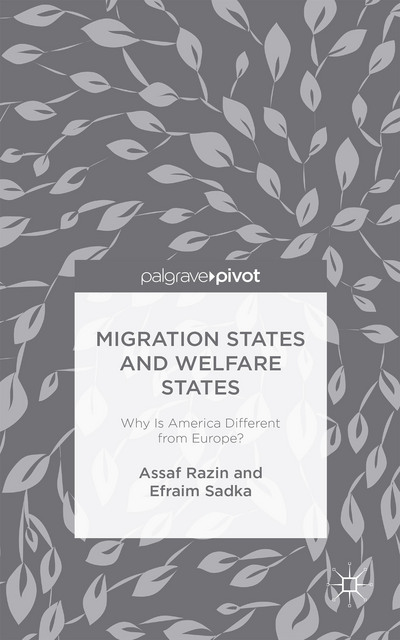
We argue that the looser federal nature of the economic union in the EU, relative
to the U.S.'s (that is, the EU member states compete one against the other, whereas the US member states are constitutionally under a Federal regime which coordinates their policies); and the relatively more aged population contribute a great
deal to our understanding of the welfare-state and migration policy differences (video).
Book review: Ethan Ilzetzki, (2016) in the Israel Economic Review Vol. 14, No. 1 (2016), 129-133
3. Migration
and the Welfare State
Political-Economy Policy Formation
Assaf Razin
Efraim Sadka and
Benjarung Suwankiri
MIT Press (2011)
Income groups' conflicting interests, and intergenerational conflicts, are behind immigration policy. A unified theoretical formal framework for studying how
political economy coallition are formed, and a range of policy
regimes are implemented. Topics include: The differences between free and policy-controlled
migration, the effect of migration on the generosity of the welfare state, the effect of aging of the population, fiscal competition and
competition over the skill mix of immigrants,and the dynamics of the political-economy policy formation concerning the interactions between the welfare state and migration.
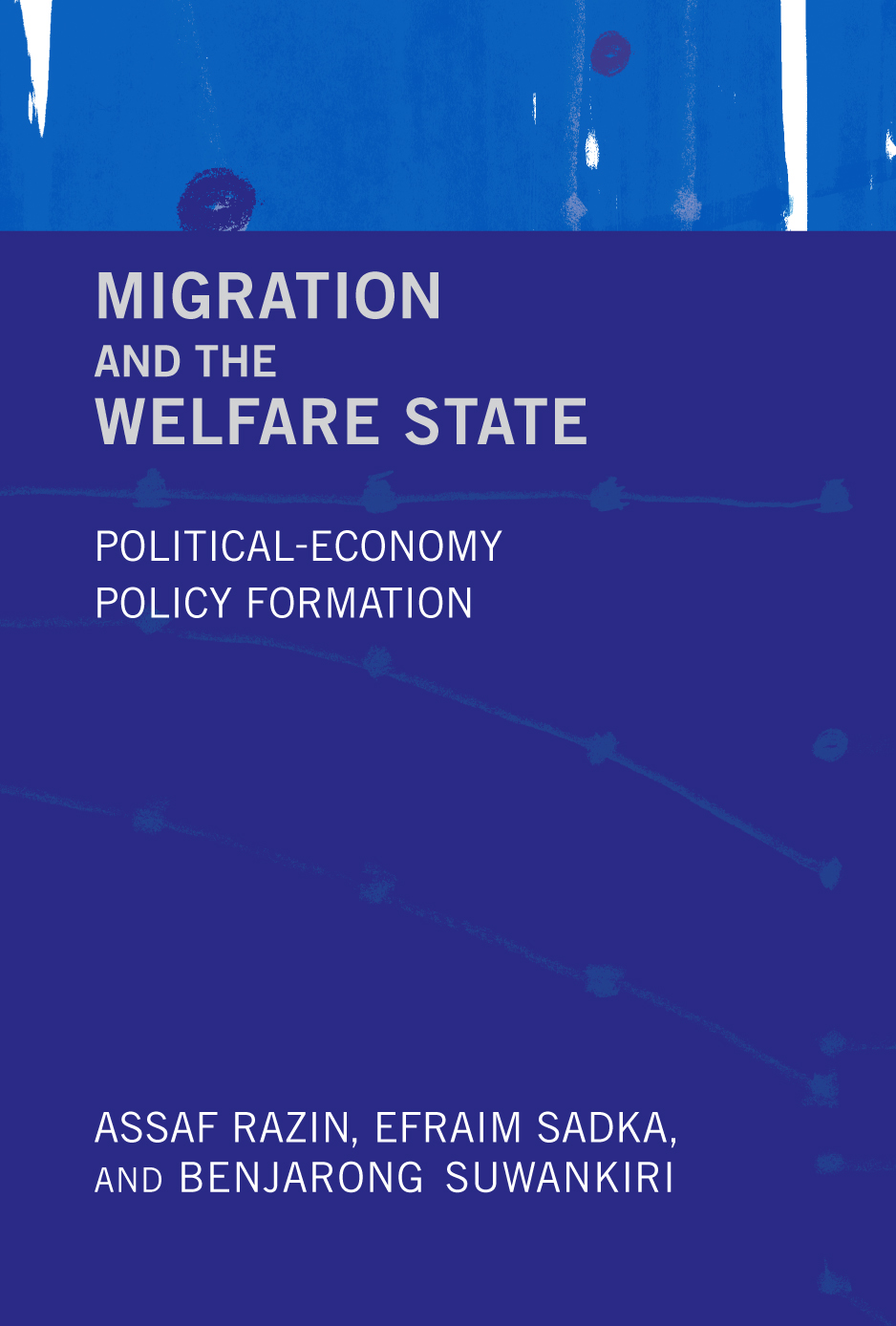
 Menashe Kadishman
Menashe Kadishman
Book review: Sharun W Mukand, Journal of Economic Literature 2012,
50(3), 791-794 (pdf).
Book Review: Johann Harnos and Hillel Rapoport, Israel Economic Review
(IsER) Vol 11, No.1, April 2014
http://www.boi.org.il/en/Research/Periodicals/Documents/11ISER5.pdf
Book Review: Alexander Kemnitz J.Econ, 107: 191-193 (2012), Springer
Werlag
http://link.springer.com/content/pdf/10.1007%2Fs00712-012-0289-1
Book Review: Mathias Sinning
Economic Record Volume 89, Issue 286, SEP 2013
http://onlinelibrary.wiley.com/doi/10.1111/1475-4932.12070/pdf
4. Foreign
Direct Investment: Analysis of Aggregate Flows
(Princeton
University Press, 2007)
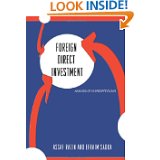
 Jerusalem in art
Jerusalem in art
Book Reviews:
K.P. Kimbrough, Foreign Direct Investment: Analysis
of Aggregate Flows by Assaf Razin and Efraim Sadka. International Review of Economics
and Finance 2009.
http://www.arts.cornell.edu/econ/arazin/kimbroughFDIBOOKreview.pdf
Kathrin
Russ, The New Theory of Foreign Direct Investment
(Review of Multinational Firms and the Theory of International Trade by Jim Markusen
and Foreign Direct Investment: A Theory of Aggregate Flows by Assaf Razin and
Efraim Sadka, for the journal International Finance, 2009 text
Laura
Alfaro, Review of Foreign Direct Investment: Analysis of Aggregate Flows, Journal
of Economic Literature, March 2009, text.
SebnemKalemli-Ozcan,
Book Review, Israel Economic Review,Vol 9, No 2 (2012), 1-3 (text)
 David
Hendler
David
Hendler  Menase Kadishman
Menase Kadishman
5. Economic
Policy in the International Economy: Essays in Honor of Assaf Razin
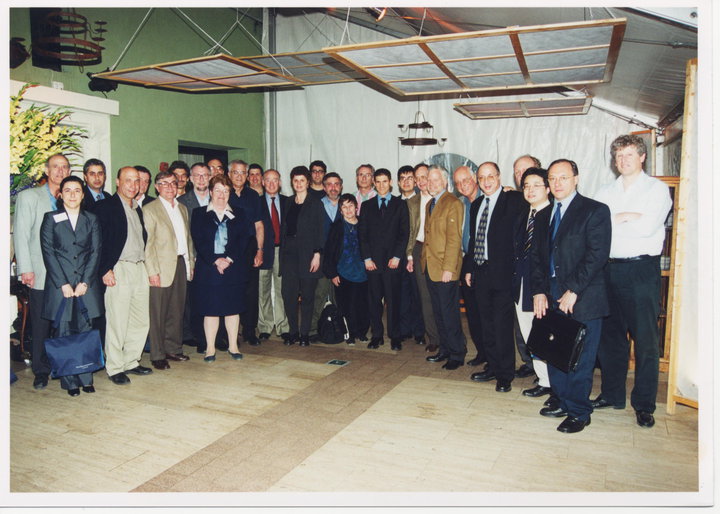
Festschrift international gathering in Tel Aviv, 2001.
Edited
by Elhanan Helpman, Efraim Sadka (Cambridge University Press, 2002)
Part
I. Financial Issues in Open Economies: Theory: 1. Crises: the next generation?
Paul Krugman;(link)
2. Solutions to the ‘devaluation bias’: some preventive measures to defend fixed
exchange rates against self-fulfilling attacks Chi-Wa Yuen; 3. Growth enhancing
effects of bailout guarantees Aaron Tornell; 4. Risk and exchange rates Maurice
Obstfeld and Kenneth S. Rogoff; Part II. Financial Issues in Open Economies: Empirics:
5. Economic integration, industrial specialization, and the asymmetry of macroeconomic
fluctuations Sebnem Kalemli-Ozcan, Bent E. Sorenson and Oved Yosha; 6. Uncovered
interest parity in crisis: the interest rate defense in the 1990s Robert P. Flood
and Andrew K. Rose; 7. When does capital account liberalization help more than
it hurts? Carlos Arteta, Barry Eichengreen and Charles Wyplosz; 8. Sources of
inflation in developing countries Prakash Loungani and Phillip Swagel; Part III.
Economic Growth: Theory and Empirics: 9. Growth effects and the cost of business
cycles Gadi Barlevy; 10. Explaining economic growth Yair Mundlak; Part IV. Public
Economies: 11. Simulating fundamental tax reform in the United States David Altig,
Alan J. Auerbach, Laurence J. Kotlikoff, Kent A. Smetters and Jan Walliser; 12.
The international macroeconomics of taxation and the case against European tax
harmonization Enrique G. Mendoza; 13. Home bias in portfolios and taxation of
asset income Roger H. Gordon and Vitor Gaspar; 14. Social dumping in the transformation
process; Part V. Political Economy: 15. Do political institutions shape economic
policy? Torsten Persson.
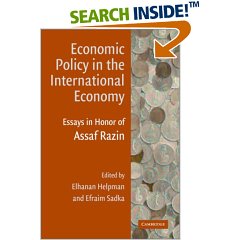
Crises: https://sapir.tau.ac.il/sites/economy.tau.ac.il/files/media_server/Economics/Sapir/conferences/Krugman.pdf
The
book Conference (IMF Survey, April 16, 2001, page
129)
6. The Decline of The Welfare
State: Demography and Globalization-- MIT
Press 2004
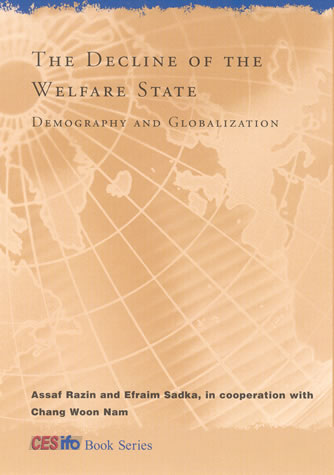
(Hebrew Slide, English
Slide)
Book Download (link)
Book Reviews:
Ortega F ECONOMICS OF TRANSITION 14 (2): 413-415
2006
Kimbrough K JOURNAL OF ECONOMIC LITERATURE 44 (1): 184-186 MAR 2006
Beltrametti L JOURNAL OF ECONOMICS 87 (2): 195-197 MAR 2006
Hicks, Alex, Governance,
An International Journal of Policy and Administration, Vol 20, Issue 2, pp. 359-71,
2007
Nicole Wolfe, Journal of World System Research, Vol 12, Num 2 ( December
2006)
Catia Montanga Economica, Volume 74, Issue 296, Novemember 2007
7.
Labor, Capital and Finance: International
Flows
by
Assaf Razin and Efraim
Sadka
Cambridge University Press 2002
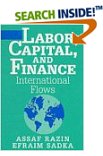
Book download
(pdf)
(text)
(link)
Book Reviews:
Wright MLJ JOURNAL OF ECONOMIC LITERATURE
42 (2): 524-525 JUN 2004 (text)
Lane P WORLD ECONOMY 25 (10): 1525-1525 NOV 2002 (Word
File)
Publisher's
release ,JEL, Amazon.com
Introduction
Preface
Table of Contents
Chapter 1,
(Figures:1,2)
Chapter 6
Chapter 7,
(Figures:,1,2)
text
 Haim Kiewe
Haim Kiewe
8. A Theory of International
Trade Under Uncertainty
Academic Press, Harcourt
Brace Jovanovitch, 1978
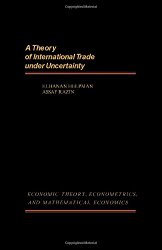
by
Elhanan
Helpman and Assaf Razin
(FullText)
Book
Reviews:
NEARY JP ECONOMICA 48 (189): 101-102 1981
POMERY
J JOURNAL OF POLITICAL ECONOMY 88 (5): 1061-1064 1980
COES DV JOURNAL OF INTERNATIONAL
ECONOMICS 10 (3): 445-448 1980
ANDERSON JE JOURNAL OF ECONOMIC LITERATURE
18 (1): 148-149 1980
HITIRIS T ECONOMIC JOURNAL 90 (357): 185-187 1980

Yosl Bergner
9. Fiscal Policies and the World
Economy: Intertemporal Approach
(MIT Press 1987 ( text)
(First
Edition, 1987; Second Edition, 1993.)
Fiscal
Policies and Growth in the World Economy (MIT Press, Third
Edition, 1996),
Preface,
Contents,
The Mundell-Fleming Model:
Chapter
4, text
The Dynamics of the Current Account:
Chapter7,
text.
Growth in the Global Economy:
Chapter
12, Chapter 13, Chapter
14, Chapter 15
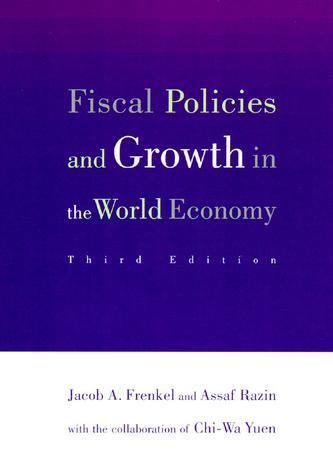
Book download
(link)
Book Reviews:
first edition (1987)
Anon
JOURNAL OF MACROECONOMICS 19 (3): 630-630 SUM 1997
BRUCE N JOURNAL OF ECONOMIC
LITERATURE 27 (4): 1704-1705 DEC 1989
MCCOY JPANNALS OF THE AMERICAN ACADEMY
OF POLITICAL AND SOCIAL SCIENCE 504: 168-169 JUL 1989
LEHMENT H WELTWIRTSCHAFTLICHES
ARCHIV-REVIEW OF WORLD ECONOMICS 125 (2): 416-417 1989
FLOYD JE JOURNAL OF
INTERNATIONAL ECONOMICS 26 (3-4): 392-394 MAY 1989
Second Edition (1992):
WRENLEWIS S WORLD ECONOMY 17 (5): 782-782 SEP 1994
10. Population Economics
Population Economics
(MIT Press, 1995), with Efraim Sadka
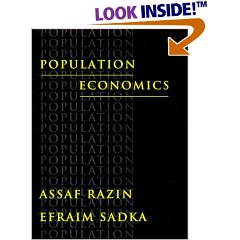
Book download
(link)
Book
Reviews:
Wildasin DE ECONOMIC DEVELOPMENT AND CULTURAL CHANGE
45 (4): 932-938 JUL 1997
Blanchet D JOURNAL OF ECONOMICS-ZEITSCHRIFT FUR NATIONALOKONOMIE
64 (2): 221-223 1996
Jackson WA ECONOMIC JOURNAL 106 (439): 1812-1813 NOV
1996
11. International Taxation in an Integrated
World
(MIT Press, 1992), with Jacob Frenkel and
Efraim Sadka
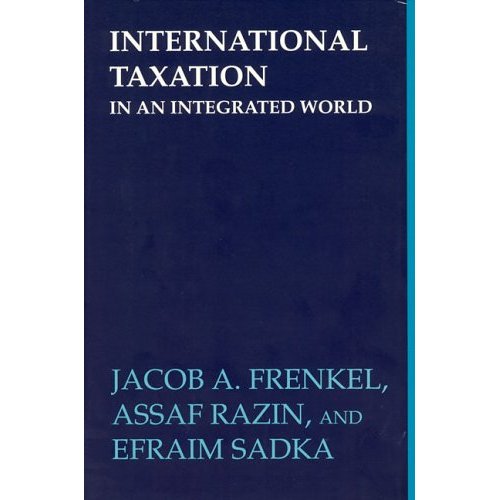
text,
(pdf)
Book
download (link)
12. Current-Account Sustainability
by
Gian Maria Milesi-Ferretti and Assaf Razin
(Princeton Studies in International Finance, No 81) Paperback (November 1996)
Princeton University, International Finance; ISBN: 0881652539
Text
see also Currency Crises
PR Krugman (ed.) 2000, Book download
(link)
13.
The Economy of Modern Israel
(University
of Chicago Press, 1993), with Efraim Sadka
text

Yohanan Simon
EDITED BOOKS
Social
Security Reform : Financial and Political Issues in International Perspective
by Robin
Brooks (Editor), Assaf
Razin (Editor)
Cambridge University Press 2006
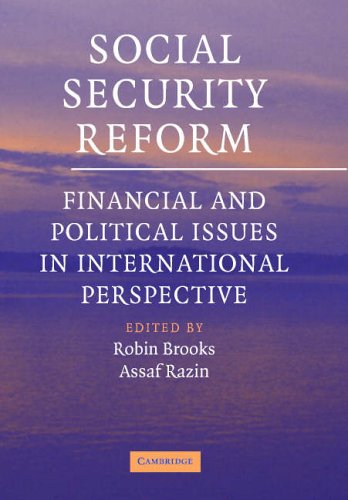
Preface,
Table of contents, Introduction,
authors
(introduction)
(Table of Contents)
Book Reviews:
SHAUN L. YOW, Journal of Pension Economics
6:01, 2007. http://journals.cambridge.org/download.php?file=%2FPEF%2FPEF6_01%2FS1474747206282842a.pdf&code=262592bf0459172aff41ae708a1ef5e1
Taxation
in the Global Economy (National Bureau of Economic Research Project Report)
by Joel Slemrod (Editor), Assaf Razin (Editor) ( Paperback -
February 1, 1992) Book Download (link)
Capital
Mobility : The Impact on Consumption, Investment and Growth
by Leonardo Leiderman (Editor), Assaf Razin (Editor) ( Cambridge University Press,
1994)
International
Trade and Trade Policy
by Elhanan Helpman (Editor), Assaf Razin
(Editor) ( MIT Press, 1991); Book
download (link)
International
Finance and Financial Crises : Essays in Honor of Robert P. Flood, Jr,
Edited by Peter Isard, Assaf Razin, and Andy Rose , Kluwer Academic
Publishers (2000)
Optimum Currency Areas: New Analytical and Policy Developments , Edited
by Mario Blejer, Leonardo Leiderman and Assaf Razin, IMF, 1997;
A pre-Nobel Award Festschrift for Robert Mundell's
"optimum currency area" paper
Capital
Mobility: The Impact on Consumption, Investment and Growth by
Leonardo Leiderman and Assaf Razin ( Paperback)
The
Economics of Globalization: Policy Perspectives from Public Economics
by Assaf Razin and Efraim Sadka ( Paperback) -
Taxation in the Global Economy by Assaf Razin and Joel Slemrod,
The University of Chicago
Development
in an Inflationary World by M. June Flanders/ Assaf Razin
( Paperback - 1981)
I. A
Graduate Course in International Macroeconomics: Integrating International
Macroeconomics and Financial Crises
Introduction
The 2008
financial crisis (pdf), Two
Camps in Macroeconomics (ppt), Euro
Crisis (ppt), Syllabus (doc,
pdf)
I. International
Financial Crises
Review of Theories
of Financial Crises (draft) (slides), Leverage
Bubbles(pdf)
The Great Depression vs. The Current
Crisis ( ppt
)
Currency and Financial
Crises of the 1990s and 2000s docx
First-Generation Currency Crises Models
Fixed
Exchange Rate under Interest Parity, first-generation crisis
,
Fixed
Exchange Rate Without Interest Parity,
Second-Generation Crises Models, Unique
equilibrium? Game Theory, Banking/Debt
Crises (ppt), notes:
1, 2, 3, 4,
6, 7, 8
Third-Generation Crises
Models
The
balance-sheet effect in financial crisis,
balance
shhet effect in a closed economy , (book
review), Financial Fragility
(doc)
Evaluation of Exchange Rate Regimes (Econ
Policy, currency pegs 2007)(pdf)
(word) (Non
linearity table) (presentation
China) (Box 1: tex,
pdf) (Box 2: tex,
pdf) (Figure)
(Revised Tables and Figures)
(tex)(pdf)
(slide1) (slide2) (Figures
and Tables)
Exchange-Rate Regimes (pdf)
Informational Cascades and Rational Bubbles
(link, Housing
Bubble)
Bank Runs and Capital
Flows
Caballero-Krishnamurty:
Flight for Quality (link, Burnside
slides)
Bank
Runs, Capital Flow
Reversals, Credit-Rating Crunches
(Figure)
Slides
(pdf, tex)
Allen and Gale (slides), (ii)
More on Currency Crises and Financial Crises
First-Generation Currency Crises Fixed
Exchange Rate With and Without Interest Parity,
Currency
Crises Models with Endogenous central bank policies, Unique
equilibrium ? Game
Theory , Banking/Debt Crises ( ppt
), notes: 1 , 2
, 3 , 4
, 6 , 7
, 8
Balance-Sheet
Crises Models
The
balance-sheet effect in financial crisis,
balance
shhet effect in a closed economy
Evaluation of Exchange Rate
Regimes in the presence of Liquidity Crises ( Econ
Policy, currency pegs 2007 ) ( pdf
) ( word
) Exchange-Rate Regimes ( pdf
)
Informational Cascades and Rational Bubbles
( link , Housing
Bubble )
Bank Runs and Capital Flows: Flight for Quality
(
link , slides
) Bank Runs,
Capital Flow Reversals,
Credit-Rating Crunches ( Figure
) Slides ( pdf
, tex
, slides
)
II. Textbook
Neo-Classical Open-economy Macroeconomics
1.
Inflation
Inflation
and Money Growth, seigniorage,
2 Exchange Rate
Flexible
Exchange Rate ,
III. The Mundell-Fleming
Model
Slides: The
Mundell-Fleming Model
IV. The New-Keynesian
Macroeconomics
The
Flexible Price Benchmark
Aggregate
Supply Under Price Rigidity
Equilibrium
under Flexible and Rigid Prices
Utility-based
loss function (Preliminaries
)
Utility-Based
loss function: Globalization
Liquidity trap and delevaraging
(link)
Loglinearization
Krugman
on liquidity trap
Liquidity
trap
The
Liquidity Trap and Expectations,
more
Fiscal
Policy under liquidity trap
Geneal Equilibrium and Interest
Rule ( doc)
Naive
vs Quadratic LQoptimazation ( doc
)
Linear Quadratic Approximation ( pdf
)
Homeworks: 1
, 2 , 3
globalization and inflation ( Slides,
pdf , word
)
Jordi Gali's notes( 1
, 2 ,
3 , 4
, 5 ,
6 , 7
)
(vi) The Dynamics of the current- and capital-
account of the balance of payments
(a) Consumption-Smoothing
current account balance Dynamics ( PPT
)
(b) Dynamics
of Savings in a small open economy ,
(c) Current
Account Stochastic Dynamics,
(d) Portfolio
View of Capital Flows ( slides
), Home works
Basics:
1 , 2
, 3
; New Keynesian Macro: Homeworks: 1
, 2 , 3
, 4 ( word
), 5 ( word
), 6 ( word
) , 7 ( word
); and More Home works.


 Rafi Peretz
Rafi Peretz



 Lea
Nikel
Lea
Nikel
 Haim Kiewe
Haim Kiewe Uri Lifshitz
Uri Lifshitz

 Naftali Bezem
Naftali Bezem
 Meir Lazar
Meir Lazar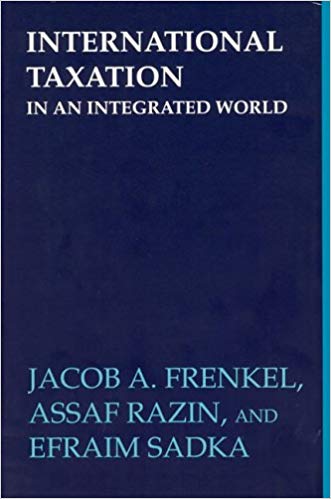
 Shahaf Kantor
Shahaf Kantor
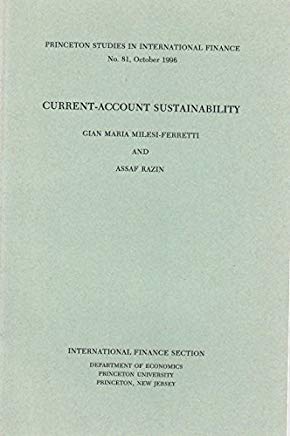

 Nahum Gutman
Nahum Gutman
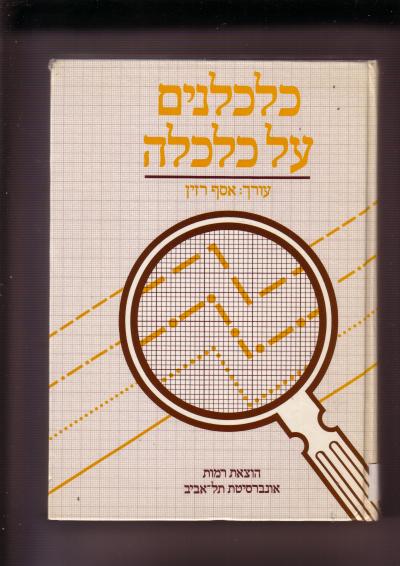


 Leo
Roth
Leo
Roth
 Ancient Chinese Artifact (Fabricated?)
Ancient Chinese Artifact (Fabricated?)


 Naftali Bezem
Naftali Bezem



 Avner Bengal
Avner Bengal
 Yair Garbouz
Yair Garbouz
 Ezekiel Shtreichman
Ezekiel Shtreichman
 Aviva Ori
Aviva Ori
 Moshe Cagan
Moshe Cagan

 Menashe Kadishman
Menashe Kadishman Neeve Razin, 2021
Neeve Razin, 2021
 Avner Bengal
Avner Bengal  Amos Keinan
Amos Keinan



 Jankel Adler
Jankel Adler


 Menashe Kadishman
Menashe Kadishman Jerusalem in art
Jerusalem in art David
Hendler
David
Hendler  Menase Kadishman
Menase Kadishman 









